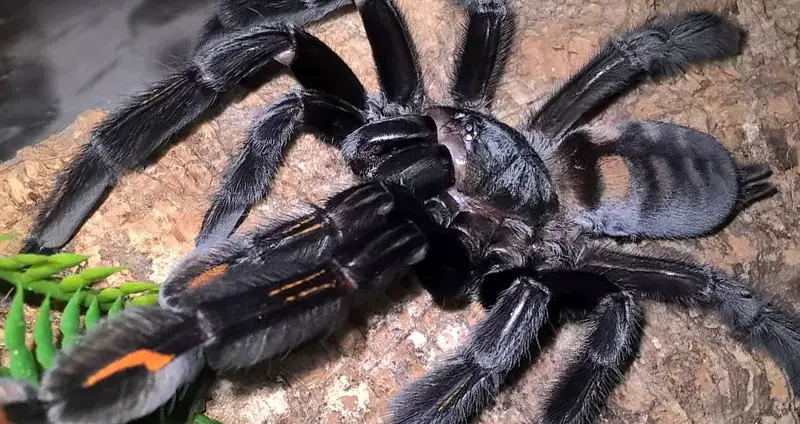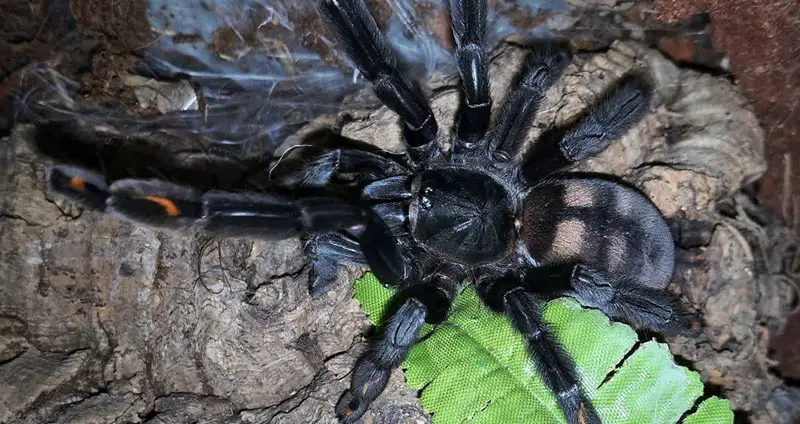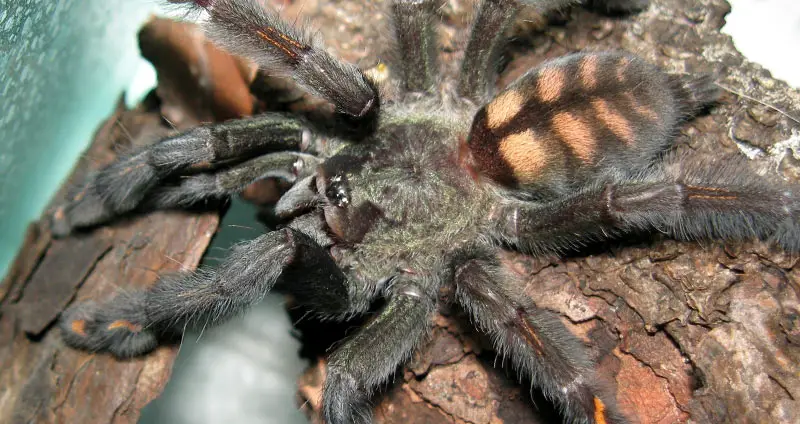Psalmopoeus irmini, also known as the Venezuelan Suntiger Tarantula, is a pretty fascinating new world tarantula with a beautiful appearance and unique temperament.
While some tarantulas are more straightforward, others have quirks that every potential owner needs to be aware of. This is one of those species.
This care sheet will tell you everything that you need to know in order to properly care for your own P. irmini from housing to temperament to diet.
Table of Contents
Psalmopoeus irminia Care Sheet
Common Name |
Venezuelan Suntiger |
Species Type |
New world arboreal |
Habitat |
Endemic to Venezuela and Guyana where the climate is relatively warm and humid year-round. |
Growth Rate |
Fast growth rate, reaching maturity in a few short years. |
Adult Size |
Females reach about 6″ in legspan, while males measure slightly smaller. |
Lifespan |
Females live for around 12 years while males only live up to 4. |
Enclosure |
The enclosure should be taller than it is wide/long with plenty of climbing space. The inside of the enclosure should have a vertical cork bark hide, a water dish, and several fake plants. |
Temp/Humidity |
Around 75°F with 60% to 70% humidity. |
Diet |
Great eaters that can eat about 7 large crickets per week. Crickets can be supplemented with dubia roaches and mealworms. |
Temperament |
Not an aggressive species, but it can definitely act skittish/nervous. Spends most of its time hiding in its burrow, but tends to come out quickly for food. |
Experience Level |
Intermediate – While it’s a new world tarantula, it’s more skittish and possesses more potent venom than most other new worlds. Care isn’t difficult, but it’s better suited for a keeper with a bit of experience already. |
Average Cost |
Slings ~ $20, Males ~ $30, Females ~ $55+ |
Psalmopoeus irminia Appearance
This tarantula has a very recognizable, striking appearance that’s made it a fan favorite.
Their bodies are a deep black color, and this is contrasted by bright orange chevron markings on their legs and a tiger stripe pattern on their abdomen.
Psalmopoeus irminia is sexually dimorphic, though, meaning that males and females look different.
Males have a grayish-brown color instead of the deep black color of females, and their orange markings are extremely faint.
In terms of legspan, males and females also differ. Females reach a max legspan of right around 6″, while males often only reach 5″.
Both sexes have fast growth rates, though, likely as a result of their shorter lifespans (12 years for females). They’re known to reach maturity in just 2-3 years.

Psalmopoeus irminia Temperament
The temperament of these tarantulas is what makes them so interesting and important to research before purchasing.
First and foremost, it should be stated that this is a new world tarantula. This kind of tarantula is known for being more calm, passive, and preferring to avoid confrontation altogether.
For the most part, Psalmopoeus irminia lives up to this. It’s certainly not an aggressive tarantula, but it’s more on the defensive/skittish side and will defend itself if necessary.
It should also be noted that instead of having urticating hairs, the Venezuelan Suntiger Tarantula possesses some of the most potent venom of all new world species. Bite reports state that bites cause lots of cramping, swelling, and prolonged localized pain.
So, a skittish temperament combined with this painful bite could be dangerous for beginner tarantula owners that aren’t sure about what they’re doing.
However, don’t let this scare you away.
By simply being conscious of the tarantula, using tweezers when feeding them, alerting them to your presence before entering the enclosure, and by moving slowly, there’s almost no chance you’ll get bitten.
Aside from that point, P. irminia spends most of its time within its enclosure hiding away in its burrow, so don’t expect to see it too frequently.
Housing Psalmopoeus irminia
Properly housing a Venezuelan Suntiger is relatively simple and doesn’t require too much effort. All that you need to do is provide a good enclosure, add a few essential accessories, and maintain an optimal internal climate.
Make sure that the enclosure is optimal before moving your tarantula into it. As this is a skittish tarantula, you don’t want to cause it any unnecessary stress.
Optimal Enclosure
As this is an arboreal tarantula, it has a strong desire to climb, so its enclosure should have plenty of height to it to allow for this. There should be adequate floor space as well, though, as Psalmopoeus irminia spends a lot of time on the ground.
The best enclosure for this species will have a vertical design, plenty of ventilation, great security, easy accessibility, and good visibility. There are a few enclosures that match these requirements.
The recommended enclosure for a mature P. irminia is the Exo Terra 12” x 12” x 18” glass terrarium. Exo Terra enclosures are the go-to enclosure for tarantula keepers that don’t want to cut any corners.
There are some DIY options out there, but you need to put a lot of effort into ensuring their ventilation and security.
Enclosure Decorations
The inside of the enclosure needs to have a few essentials to keep this species comfortable and healthy. This step is fairly simple, fortunately.
First of all, there needs to be about 5 inches of moisture-retaining substrate lining the floor of the enclosure. Coconut fiber substrate works great for this.
While this much substrate is typically used in terrestrial enclosures, this arboreal species still loves to burrow and will spend most of their time hidden in their substrate.
So, not only will this substrate allow for sizable burrows to be made, but it also keeps the enclosure cleaner and maintains a consistent humidity level.
On top of the substrate you’ll want to stand a piece of cork bark up vertically to act as a tree trunk/hide combo. This is what Psalmopoeus irminia will climb up.
A water dish should also be present so that it can contribute to the enclosure’s humidity and prevent dehydration.
Then, you can add some fake plants, sphagnum moss, and a few rocks and sticks to the enclosure to round things out and make it look more natural and diverse.

Enclosure Temperature/Humidity
This species is endemic to Venezuela and Guyana where temperatures and humidities are consistently high year-round. This should be reflected in the climate within the enclosure to a degree.
The optimal temperature for P. irminia is right around 75°F, which happens to be room temperature for most people. Because of this, supplemental heating shouldn’t be needed.
If your house frequently drops below this temperature, though, you need to use either a space heater or a gentle heat lamp that doesn’t emit any light.
For humidity, aim for around 60% to 70%. This is nothing extreme, and can be maintained with very little effort.
Simply keep the water dish cleaned and filled at all times, and spray down part of the substrate with water about 2 times per week.
It’s difficult to eyeball humidity levels, so use a thermometer/hygrometer to monitor environmental conditions so that you can make small changes as needed.
Diet
While Psalmopoeus irminia is a unique tarantula in several different ways, it’s not unique in its diet. This spider can be fed a standard tarantula diet.
As spiderlings, this tarantula can be given pinhead crickets and flightless fruit flies as frequently as they’re willing to eat.
As they age, you need to start transitioning them to larger prey.
Adults can eat about 7 large crickets per week, and this can be diversified with some mealworms and dubia roaches.
The Venezuelan Suntiger is an excellent eater, attacking its prey with a vengeance and quickly subduing it.
Just be sure to wait about 14 days after a molt to attempt to feed your tarantula again. This waiting period is essential to give them time for their fangs to harden and for them to become less vulnerable.
Health Concerns
Pet tarantulas rarely experience health problems due to the consistent and safe environment that most of them are kept in. So, as long as you keep yours in a good enclosure and feed it a good diet, few problems should arise.
If your tarantula does experience any problems, it’s likely either dehydration or mite infestations. Fortunately, both of these problems are easy to fix or simply avoid altogether.
First of all, this is an arboreal tarantula, so it needs to have plenty of space to climb. If its enclosure doesn’t meet its needs, its growth may be hindered and it may develop several other problems.
Additionally, this is a very skittish and unpredictable tarantula when it comes to interaction with you.
If you don’t take the necessary precautions, P. irminia may bite you, jump out of its enclosure, or cause harm to itself in some other way. Always be cautious when interacting with this species.
Psalmopoeus irminia For Sale & Price
Who is this tarantula best for? Because of its speed and the potency of its venom, it’s not best for beginners…
I would say that this tarantula is great for keepers that have experience with several new world species and are looking to transition into old world tarantulas. This isn’t an old world species, but it’s a mellow version of one, so it’s a good introduction.
Purchasing one of these tarantulas is very affordable. Spiderlings sell for as cheap as $20, and females sell for as cheap as $55. This is way cheaper than many other tarantulas out there, making it very accessible.
Of course, there are other costs of ownership, but you’re still looking at a very affordable tarantula.
So, if you want a bit of a challenge without the full danger of an old world tarantula and wouldn’t mind a bizarre-acting arboreal, Psalmopoeus irminia is the perfect tarantula species for you!

